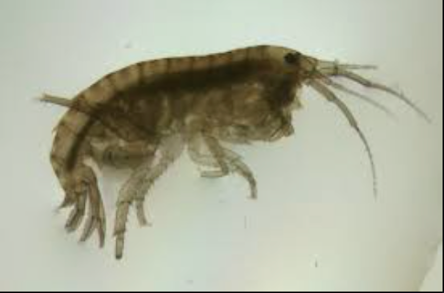DCU Mesocosm #3 Gammarids
Step 3. Sourcing easily obtainable and culturable species for assessment - gammarids
The first set of freshwater species was selected and the criteria were: (i) a gammarid, (ii) a daphniid, (iii) plus another species of crustacean.
(i) Gammarid
'Gammarid' refers to belonging to the suborder Gammaridae Latreille 1802
Ideally, we would prefer to use the native species (Gammarus duebeni ssp celticus Stock & Pinkster) but these are problematic for a number of reasons, not least because some are under pressure from similar non-native introductions. Gammarus pulex (Linnaeus 1758) is the typical gammarid chosen for mesocosms but it tends to eat its own species and it is oxygen-dependent.
The species we chose to use was Hyalella azteca (Saussure 1858) which is a gammarid in the family Dogielinotidae Gurjanova 1953.
Video of the starter Hyalella azteca culture at home:

References:
Dick, J.T.A. et al. (1993) Replacement of the indigenous amphipod Gammarus duebeni celticus by the introduced G. Pulex: differential cannibalism and mutual predation. Journal of Animal Ecology, 62(1): 79–88.
Lizotte, R.E., Testa, S., Locke, M.A. et al. Responses of Phytoplankton and Hyalella azteca to Agrichemical Mixtures in a Constructed Wetland Mesocosm. Arch Environ Contam Toxicol 65, 474–485 (2013). https://doi.org/10.1007/s00244-013-9927-z
Stanley JK, Brooks BW, La Point TW. A comparison of chronic cadmium effects on Hyalella azteca in effluent-dominated stream mesocosms to similar laboratory exposures in effluent and reconstituted hard water. Environ Toxicol Chem. 2005 Apr;24(4):902-8. doi: 10.1897/04-042r.1. PMID: 15839565.
Hyalella azteca (Saussure 1858)
Video of the starter Hyalella azteca culture at home:

References:
Dick, J.T.A. et al. (1993) Replacement of the indigenous amphipod Gammarus duebeni celticus by the introduced G. Pulex: differential cannibalism and mutual predation. Journal of Animal Ecology, 62(1): 79–88.
Lizotte, R.E., Testa, S., Locke, M.A. et al. Responses of Phytoplankton and Hyalella azteca to Agrichemical Mixtures in a Constructed Wetland Mesocosm. Arch Environ Contam Toxicol 65, 474–485 (2013). https://doi.org/10.1007/s00244-013-9927-z
Stanley JK, Brooks BW, La Point TW. A comparison of chronic cadmium effects on Hyalella azteca in effluent-dominated stream mesocosms to similar laboratory exposures in effluent and reconstituted hard water. Environ Toxicol Chem. 2005 Apr;24(4):902-8. doi: 10.1897/04-042r.1. PMID: 15839565.



Comments
Post a Comment